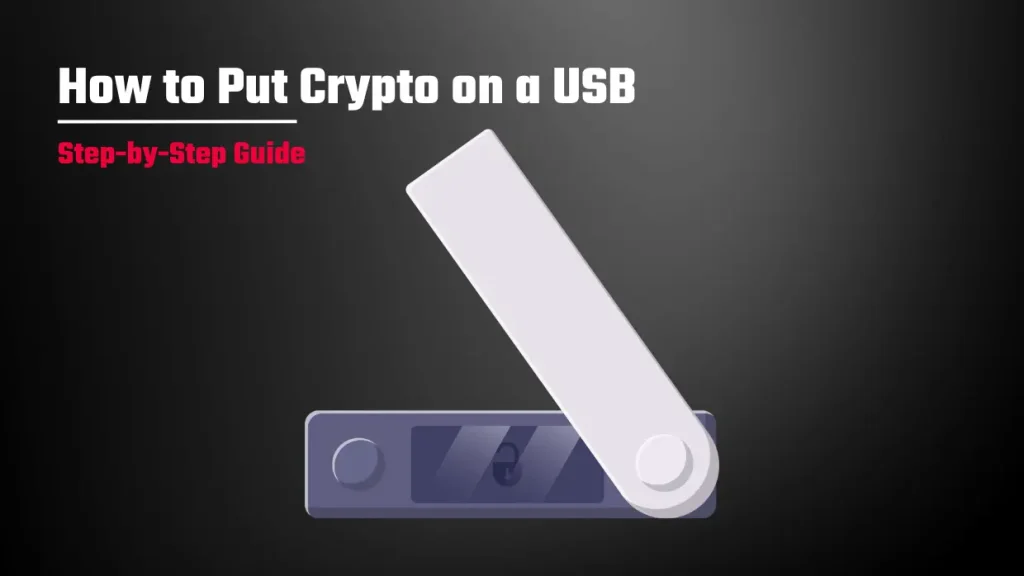When I first got to cryptocurrencies, I was told that the only proper way of storage is to own a hardware wallet.
While this is true, it doesn’t mean that other ways of storage aren’t safe at all. But they have their own drawbacks. Exchanges can be hacked at any given moment, and software wallets, such as Exodus, are only as safe as your device.
However, hardware wallets can be pricy and can be a bit redundant for casual crypto enthusiasts. Then there’s this middle path—putting crypto on a USB. Essentially any USB flash drive can be turned into your personal crypto wallet.
And it is quite simple, so let’s get started!
| Key Takeaways |
|---|
| A USB crypto wallet is a great alternative to safely store smaller holdings |
| The biggest drawback is that a flash drive needs to be connected to a computer to use |
| To use it, get your favorite crypto wallet software onto a bootable flash drive |
Can You Put Crypto on a USB Drive Instead of a Hardware Wallet?
When crypto got into popularity, people quickly realized that storing something decentralized online wasn’t the best option. Thanks to the decentralization, your options are very limited if something happens to your assets. Multiple companies focused on solving this problem, creating a device that eliminates nearly all the risks—a hardware wallet.
Because a hardware wallet is not connected to the internet, no one can access your holdings without having your device in hand.
To better understand this it's important to realize, that a crypto wallet is just a tool to interact with the blockchain. A wallet does not hold the cryptocurrencies, it is there to make using it possible with the use of private keys.
A hardware crypto wallet does not need a ton of computing power—it is not running a full-node. A private keys are only a string that can be stored everywhere, even on a USB drive you use for your photos.
USB crypto wallet can be an excellent temporary solution, but it might not be as reliable long term as a specialized hardware wallet. Here are all five steps you need to do to put crypto on a USB.
How to Turn a USB Drive into a Crypto Wallet
Storing cryptocurrency on a USB flash drive isn’t hard. It consists of five simple steps, that will likely take you less than five minutes to complete.
The hardest part is choosing a reliable crypto wallet software. After that, grab a USB drive, install the wallet, and import your private keys—all set and done, and you can sleep in peace knowing that your assets are safe.
1. Prepare the USB Drive
You obviously shouldn’t be choosing the cheapest option. Any USB will do, but if you can opt for one that:
- Comes with encryption
- Has long lifespan
USB drives that come with encryption are usually a bit pricier. Although not recommended, if you want to keep the costs down, you can format any flash drive and encrypt it yourself. Consider using VeraCrypt or BitLocker, which is already preinstalled on Windows devices.
2. Download your Favorite Crypto Wallet to the Computer
Look through the internet for a software crypto wallet with a cold storage feature—a wallet that can function without internet access.
You can opt for Coinomi Wallet or Electrum Wallet. Both are very reliable and easy to use. I had a better time using Coinomi, but try multiple ones to see which suits you the best.
3. Disconnect from the Internet
Remember the purpose of a hardware wallet? They are not connected to the internet. To stay safe, you want to recreate this. So from now on, anytime you want to sign a transaction or check your crypto, you should unplug the Ethernet cable or turn off the WiFi before plugging in your USB.
4. Install the Wallet Software to the USB Drive
Connect your USB drive while disconnected from the internet and run the installation client. Once the software asks for the installation location, select your USB.
5. Create a Strong Password and Import your Private Keys
Once the software installation is completed, launch the wallet. Depending on your chosen wallet, you’ll be walked through a few steps asking you for a password used to unlock the wallet on your device and for private keys or a seed phrase.
Complete the setup following the steps, and once you’re done, you can unplug your USB from the computer.
Always use the safe eject feature to remove your USB! You don’t want your data to be corrupted!
Bottom Line
Turning a USB drive into a crypto wallet is not hard—just a few minutes and a few steps.
It’s a simple and secure way to store your cryptocurrency. And an affordable one! That makes it a great way for new crypto holders who wish to try a few things out before jumping into buying an expensive hardware wallet.
They don't have to be always that expensive—check out SecuX with our 10% discount, applied automatically to all devices at the checkout.
But it should not be your final destination. USB drives are great for storing Word documents or movies, it might not be ideal for sensitive data, such as your private keys.

